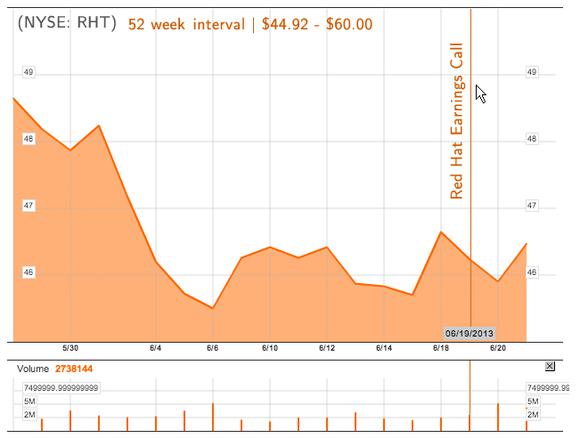Most people with at least basic knowledge of IT infrastructure have heard about Red Hat, Inc. (NYSE:RHT). The company provides one of the most widely-used operating systems for servers. The reason why many consumers may have not heard about this operating system is because Red Hat is mainly for organizations, especially those willing to pay a premium for improved security. Therefore, Red Hat isn’t just another IT stock. The name is synonymous with security, reliability, and fast performance – three must-have success factors that many start-ups would love to possess. Although Red Hat’s cash cow resides in its open source solutions, recently the company has been giving more importance to its cloud storage and virtualization solutions, a fierce business segment where Rackspace Hosting, Inc. (NYSE:RAX) has also been very actively.
However, Red Hat, Inc. (NYSE:RHT) is the only company that started as an open source OS provider and then shifted to cloud services. As you will see later, Red Hat’s open source origins could become a competitive advantage in the war for cloud market share.
This article develops a bull case for Red Hat, Inc. (NYSE:RHT), taking into consideration the latest earnings results (June 19, 2013), where the company missed the revenue consensus, but won against the Street’s earnings estimates. To maintain neutrality, I present the relevant facts about this stock: the good, the bad, and the ugly.

The Good
Red Hat, Inc. (NYSE:RHT)’s revenue continues growing: first quarter revenue came out at $363 million (up 15% y/y), first quarter subscription revenue came out at $316 million (up 16% y/y), and operating cash flow came out at $142 million (up 14% y/y). The best thing is that revenue is getting more diversified, which is a good signal that Red Hat knows how to address an extremely dynamic and competitive IT industry. In 2005, the company revenue was 100% derived from a subscription business model, but, now, Red Hat is more focused on cloud computing. Subscriptions continue to be the main revenue driver, but there are some other promising aspects like the training and services component ($47 million, up 13% y/y) and middleware services revenue.
Also, after examining Red Hat, Inc. (NYSE:RHT)’s operating expenses, you will see a promising focus on spending on growth opportunities for the future. R&D grew 27%, reflecting additions from last year’s acquisitions and the hiring of new engineers for cloud management, Red Hat OpenStack, and OpenShift technologies, among others. These services are Red Hat’s future and it makes sense to invest heavily in them now. Eventually, the company will reap the rewards from these investments.

Red Hat Storage Solutions, OpenStack, and OpenShift technologies do not produce any significant revenue at the moment, but the picture is likely to change enormously in the next two years. Investing now means getting in at a very early stage of the cycle of Red Hat’s cloud businesses.
The Bad
The growth rate of revenue continues to decrease. Growth has decelerated below 20% over the last year. Management uses terms like “macroeconomic challenging environment” as possible explanations for this decrease. The truth is that the U.S. federal business, which is extremely important for Red Hat, was quite weak in the May quarter. Add to this the fact that many European organizations and governments are still focusing on austerity and you have a strong negative macroeconomic effect on Red Hat’s revenue. Earnings were also hurt by adverse currency fluctuations, specifically the Yen depreciation.
The Ugly
Red Hat, Inc. (NYSE:RHT)’s most promising future products include version seven of Red Hat Enterprise Linux (RHEL) and Red Hat Storage Server, which is software that allows companies to manage server hardware infrastructure easily, and is similar to Amazon.com, Inc. (NASDAQ:AMZN) Web Services. RHEL7, which I expect to be available by the end of 2014, will definitely be a hit, as there hasn’t been any major release in the past two years. The problem lies with Red Hat Storage because competition in this business segment is extremely fierce.
Amazon Web Services (AWS) will be a hard competitor to beat. AWS may be so powerful that it could be one of the reasons why Red Hat’s negative momentum improved in the past six months. And, while Red Hat may target different clients than AWS, the truth is that many companies are considering moving their operations from private cloud environments (where Red Hat is a must-have) to AWS. Notice also that, according to Morgan Stanley, AWS is expected to increase from 0.6% of workloads to 2.3% in the next three years, which implies less pricing power for Red Hat and a fierce fight for customers.
That being said, we at least can be sure that Red Hat and its storage solutions will continue being the best choice for many federal organizations and financial institutions. Therefore, fierce competition may cause further deceleration in revenue growth rate, but not enough to cause revenue levels to decrease y/y. The fact that, unlike Rackspace, Red Hat is not completely exposed to the risks and rewards that the cloud storage arena brings makes the stock more attractive.
At any rate, further deceleration in revenue is probably the worst scenario, considering that Red Hat happens to keep an ace up its sleeve: Red Hat Open Stack, which will be included in its operating system very soon. Open Stack can be thought as a product specifically designed to compete against AWS, an open source project for building either a public or private cloud running on standard hardware.
Interestingly, Open Stack has one more backer: Rackspace Hosting, Inc. (NYSE:RAX). Like Red Hat, Rackspace’s stock performance has been poor in the past 12 months, as the company continues facing pricing pressures in its hosting solutions. But, Rackspace and Red Hat have more than one thing in common: both are suffering the consequences of Amazon.com, Inc. (NASDAQ:AMZN) Web Services. Therefore, it makes sense that they are together in the same project. They are competitors, but at the same time they realize the benefits of cooperating to develop top quality open source technology. Will Open Stack manage to drive significant revenue in the next quarters? I believe the product is superior to AWS, but we may not see any revenue effect soon. Open Stack needs time to get some relevant market acceptance. But, once it gets this, it could become the leading open source cloud computing platform standard, and bring significant revenue to Rackspace and Red Hat.
The bottom line
It is too early to make any final conclusions about the success of Open Stack. But, precisely because it is too early, this could be an excellent moment to be long in Red Hat. The stock price is close to its 52-week low and the overall atmosphere is bearish, which suggests that the Street does not believe in Red Hat’s potential to become a leading cloud computing company by 2015. However, Red Hat is taking concrete steps toward that goal. Furthermore, a better macroeconomic environment, the launch of RHEL 7, and Open Stack are all strong reasons to believe Red Hat’s revenue growth is about to see some acceleration in the next months.
The article Red Hat: The Good, the Bad, and the Ugly originally appeared on Fool.com and is written by Adrian Campos.
Adrian Campos has no position in any stocks mentioned. The Motley Fool recommends Amazon.com and Rackspace Hosting (NYSE:RAX). The Motley Fool owns shares of Amazon.com. Adrian is a member of The Motley Fool Blog Network — entries represent the personal opinion of the blogger and are not formally edited.
Copyright © 1995 – 2013 The Motley Fool, LLC. All rights reserved. The Motley Fool has a disclosure policy.






